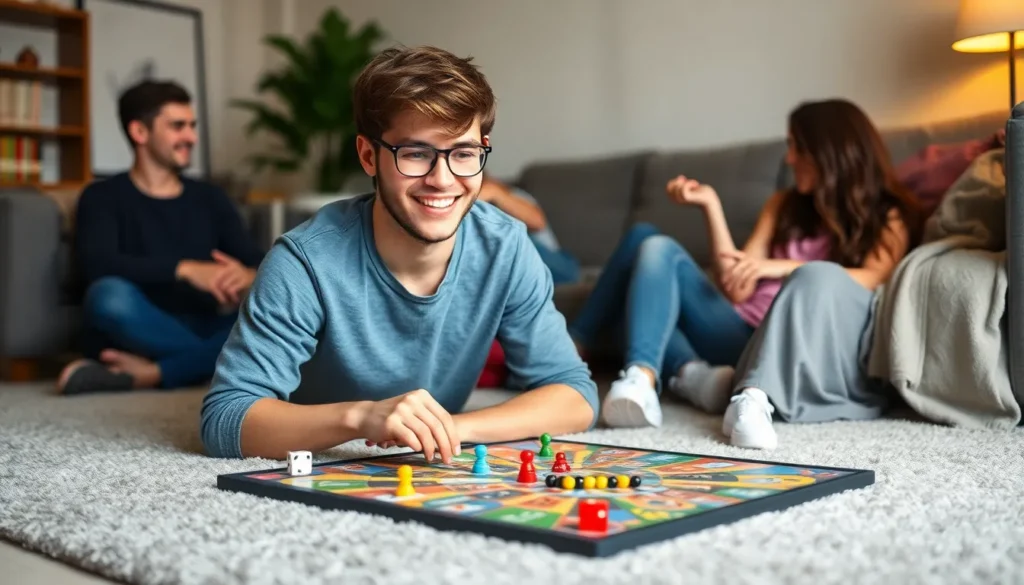Table of Contents
ToggleIndoor games have become a staple in many households, offering fun and entertainment regardless of the weather outside. They provide a perfect opportunity for families and friends to bond, engage in friendly competition, and unwind after a long day. From classic board games to modern video games, the variety available ensures there’s something for everyone.
As technology evolves, so do the options for indoor activities. These games not only stimulate the mind but also encourage physical activity, creativity, and teamwork. Whether it’s a strategic chess match or a lively game of charades, indoor games foster social connections and enhance cognitive skills. Embracing these activities can transform any dull afternoon into an exciting adventure.
Overview Of Indoor Games
Indoor games encompass a wide range of activities enjoyed indoors, providing engagement and opportunities for social interaction. These games vary in format, style, and objectives, appealing to different age groups and interests.
Definition And Types
Indoor games refer to activities played within enclosed spaces, typically among small to large groups. Types include:
- Board Games: Examples are Monopoly, Chess, and Scrabble, which encourage strategy and critical thinking.
- Card Games: Variants like Poker, Uno, and Solitaire foster social interaction and skill-building.
- Video Games: Platforms such as consoles and PCs offer immersive experiences through genres like action, adventure, and puzzle-solving.
- Tabletop Games: Dungeons & Dragons and similar RPGs provide narrative-driven experiences that promote creativity.
- Physical Games: Games like table tennis, darts, and indoor basketball enhance physical activity while being confined to indoor settings.
Benefits Of Indoor Games
Indoor games deliver several advantages, contributing to overall well-being and social development. Benefits include:
- Cognitive Stimulation: Games like chess and puzzles enhance problem-solving skills and memory.
- Social Interaction: Multiplayer formats foster teamwork and communication skills among players.
- Stress Relief: Engaging in indoor games serves as a recreational outlet, reducing anxiety and promoting relaxation.
- Physical Activity: Games like table tennis provide exercise, improving coordination and fitness levels.
- Creativity Enhancement: Role-playing games stimulate imagination and creative thinking during gameplay.
Indoor games represent a vital component of leisure time, offering numerous benefits while enhancing social dynamics and mental agility.
Popular Indoor Games

Indoor games cover a broad spectrum of activities, appealing to various interests and age groups. Here’s a closer look at some of the most popular types.
Board Games
Board games, such as Monopoly, Chess, and Scrabble, engage players in strategy, negotiation, and creativity. They often include a game board, pieces, and rules, fostering teamwork and social interaction. Many games come with expansions or different versions, offering new experiences and challenges. These games encourage critical thinking and problem-solving skills while providing hours of enjoyment for families and friends.
Card Games
Card games like Poker, Uno, and Bridge provide flexible entertainment options, requiring either skill or luck. Typically consisting of a standard deck or specialized cards, these games can accommodate small or large groups. They enhance memory, strategic planning, and social skills. Variations of popular card games keep the format fresh and exciting, ensuring players return for more.
Video Games
Video games encompass various genres, including action, adventure, puzzle, and simulation. Platforms include consoles, PCs, and mobile devices, making them accessible for many players. Popular titles like Fortnite, Minecraft, and The Legend of Zelda encourage coordination, strategy, and critical thinking. Many video games also promote teamwork through multiplayer modes, allowing friends and family to connect regardless of distance.
Health Benefits Of Indoor Games
Indoor games offer numerous health benefits, enhancing both physical fitness and mental health. Engaging in these activities fosters well-being among participants, regardless of age.
Physical Fitness
Indoor games promote physical fitness through active participation. Games like table tennis, darts, or even dance-based video games encourage movement, improving cardiovascular health and coordination. Regular engagement in these activities can lead to increased muscle strength and flexibility. A study from the American Heart Association indicates that physically engaging games can contribute to overall fitness levels, making it easier to maintain a healthy weight.
Mental Health
Indoor games support mental health by providing a stimulating environment that fosters social connections. Engaging in games enhances cognitive skills such as problem-solving and critical thinking. Furthermore, games create opportunities for friendly competition, reducing stress and improving mood. According to the Mayo Clinic, social interaction through games can lead to decreased feelings of loneliness and increased feelings of happiness. Many indoor games also require strategic thinking, which keeps the mind active and engaged, benefiting overall cognitive health.
Tips For Setting Up An Indoor Games Space
Creating an effective indoor games space enhances the gaming experience. Consider the following aspects to optimize the environment.
Space Requirements
- Room Size: Select a room with ample space to accommodate multiple activities. A minimum of 100 square feet provides room for various games.
- Flooring: Ensure the flooring supports the activities. Use carpet for board games to reduce noise or hardwood for active games requiring movement.
- Lighting: Favor natural light for a vibrant atmosphere. If that’s not possible, opt for adjustable soft lighting to minimize glare on screens or boards.
- Ventilation: Maintain good airflow in the space. Install ceiling fans or open windows to keep the environment comfortable.
Equipment Needed
- Games Collection: Gather a variety of games catering to different age groups. Include a mix of board games, card games, video games, and physical games to ensure options.
- Seating Arrangement: Choose comfortable, movable seating like bean bags or folding chairs to adapt to various group sizes.
- Storage Solutions: Use shelves or bins for organized storage. Keeping games accessible and tidy enhances the gaming experience.
- Gaming Accessories: Stock essential accessories such as cards, dice, controllers, and score sheets. These facilitate smooth gameplay and minimize disruptions.
Indoor games serve as a vital resource for entertainment and social interaction. They bring people together and create lasting memories while enhancing cognitive and physical well-being. The diverse range of options ensures that everyone can find something enjoyable, whether it’s a classic board game or an engaging video game.
Creating an inviting space for these activities can further amplify the experience. With the right setup and a variety of games, families and friends can transform ordinary days into extraordinary moments filled with laughter and connection. Embracing indoor games not only enriches leisure time but also nurtures relationships, making them an essential part of everyday life.




